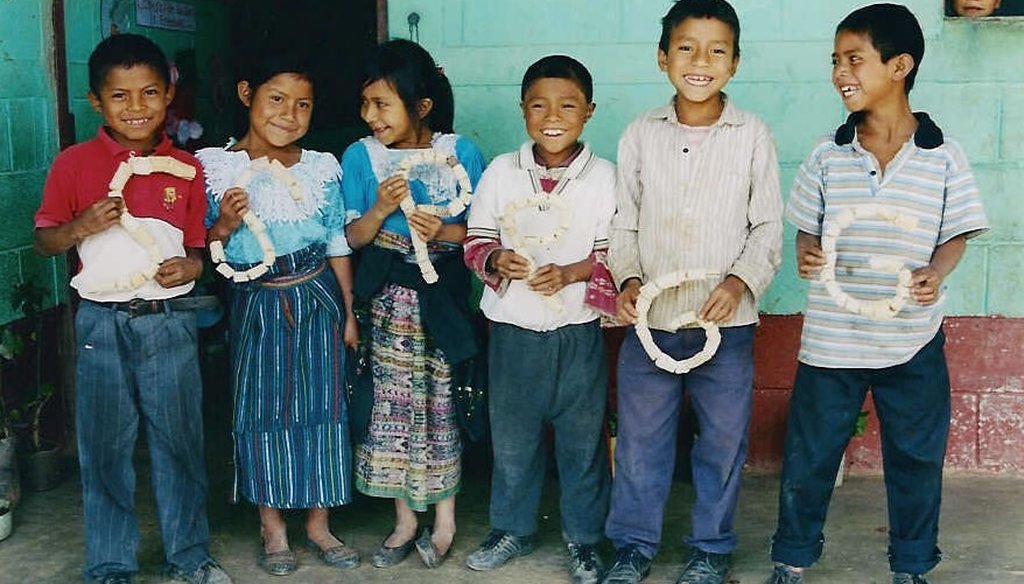Stand up for the facts!
Our only agenda is to publish the truth so you can be an informed participant in democracy.
We need your help.
I would like to contribute

Children at a rural school in Guatemala. (USAID)
When the United Nations unveiled the eight target areas that would make the world a better place in 2000, there was much skepticism that international leaders had bitten off more than they could chew. The Millennium Development Goals as they were called came with a long list of quantifiable targets for health, hunger, education and more, to be achieved by 2015.
While the effort did fall short in some areas -- reversing the spread of HIV/AIDS being the chief example -- its accomplishments on many other fronts was an effective response to the doubters.
Gayle Smith became administrator of the United States Agency for International Development (USAID) in December 2015, and on the eve of congressional hearings to defend next year’s budget request, Smith went to Capitol Hill to give her first major policy speech.
She referenced several major gains in reducing global poverty and advancing education. We fact-checked three.
Reduce extreme poverty by half
"I think everyone in the room knows that this is a moment of extraordinary progress," Smith told lawmakers. "Over the last 30 years, extreme poverty has been cut in half. Boys and girls are enrolling in primary school at nearly equal rates, and there are half as many children out of school today as there were 15 years ago."
Looking at extreme poverty, we found that by some measures, Smith actually undersold the gains.
In 2008, the UN defined poverty as living on $1.25 a day or less. According to a major UN report, the proportion of people living in extreme poverty fell from 36 percent in 1990 to 15 percent in 2011 — a 58 percent reduction in 21 years.
By the current metric of $1.90 a day, the decline is even greater. According to the World Bank, 1.9 billion people (or 37.1 percent of the global population) lived on less than $1.90 a day in 1990, compared to a projected 702 million (9.6 percent) in 2015. That’s a 74.1 percent decline in 25 years.
Now, to some extent, setting the poverty line is always a judgment call, and there are other approaches.
For example, in a 2012 working paper, the World Food Programme’s Ugo Gentilini and the Institute of Development Studies’ Andy Sumner looked at national poverty lines and found that 1.5 billion people are poor, according to their own countries — more than double the number under the World Bank’s definition.
But using the UN’s framework, Smith was on solid ground. Making allowances for the vagaries of how one defines extreme poverty and the yardstick one uses to measure it, we rated Smith’s statement Mostly True.
Reducing the number of out-of-school children
Smith also highlighted progress toward getting more young children into school, saying "there are half as many children out of school today as there were 15 years ago."
Due primarily to war, gender bias and the demand for child labor, nearly 60 million children who ought to be in primary school are not. Smith’s statement was based on the United Nations 2015 Millennium Development Goals report. In the section on education, it says, "Currently, 57 million children of primary school age are estimated to be out of school, down from 100 million in 2000." And in a list of bullet points, the report says the number has "fallen by almost half."
If you do the math, the actual estimated decline is 43 percent.
So what we have is a sort of statistical glide. The writers of a UN report massaged 43 percent to make it "almost half," then someone at USAID moved things a bit further by dropping the qualifier "almost" and Smith ends up saying "there are half as many children out of school."
This might not matter, except the United Nations Educational, Scientific and Cultural Organization, better known as UNESCO, said in 2015 that progress stalled in 2007 and since 2010, the number has been rising.
According to UNESCO, the latest data show a decline of about 40 percent since 2000. Given all these issues, we rated this claim Half True.
Worldwide income gains
Lastly, Smith said that since 1990, "every continent has seen substantial gains, with individual incomes growing by more than a third in every region of the developing world."
The USAID press office told us the numbers came from the World Bank. The measure the agency used was Gross Domestic Product per person. The World Bank makes the numbers for each region comparable by correcting for the purchasing power of consumers in each country, and putting everything in constant 2011 dollars.
"Between 2014 (the last year for which data are available) and 1990, per capita income, in real terms and adjusting for purchasing power, has increased by more than one-third in every region, ranging from 34 percent in Sub-Saharan Africa to 192 percent in East Asia and the Pacific," press staff told us.
We checked Smith’s numbers against the World Bank data and they hold up. The only issue of note is that while per capita GDP can rise, it certainly does not mean that all boats were lifted equally. The gains have been skewed to those who are most well off.
With that caveat in mind, we rated the statement Mostly True.
Our Sources
PolitiFact Global News Service, USAID head highlights worldwide income gains, March 24, 2016
PolitiFact Global News Service, Did we really reduce extreme poverty by half in 30 years?, March 23, 2016
PolitiFact Global News Service, USAID head overshoots gains on getting more kids into school, March 17, 2016
United Nations, Millennium Development Goals progress chart, 2015




















































